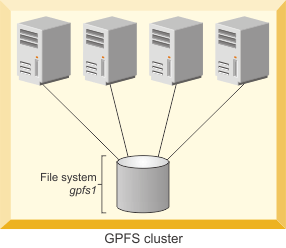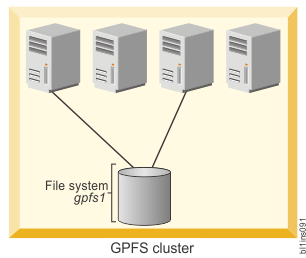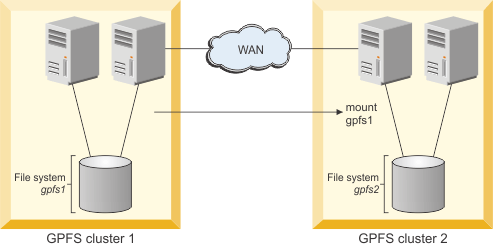IBM Spectrum Scale cluster configurations
An IBM Spectrum Scale™ cluster can be configured in a variety of ways. The cluster can be a heterogeneous mix of hardware platforms and operating systems.
- Application I/O performance and reliability requirements
- Properties of the underlying storage hardware
- Administration, security, and ownership considerations
Understanding these requirements helps you determine which nodes require direct access to the disks and which nodes should access the disks over a network connection through an NSD server.
- All nodes attached to a common set of LUNS
- Some nodes are NSD clients
- A cluster is spread across multiple sites
- Data is shared between clusters
All nodes attached to a common set of LUNS
- The maximum number of nodes accessing a LUN you want to support
- The fact that you cannot mix different operating systems with IBM Spectrum Scale to directly access the same set of LUNs on SAN.

Some nodes are NSD clients
In this type of configuration, only some nodes are connected to disks. Other nodes access the disks using the NSD path.

IBM Spectrum Scale Servers and clients
You can configure an IBM Spectrum Scale cluster in which some nodes have a direct attachment to the disks and others access the disks through other IBM Spectrum Scale nodes. This configuration is often used in large clusters or to provide a cost-effective, high-performance solution.
When an IBM Spectrum Scale node is providing access to a disk for another IBM Spectrum Scale node, the node that provides access is called an NSD Server. The node that accesses the data through an NSD server is called an IBM Spectrum Scale client.
Sharing data across multiple IBM Spectrum Scale clusters
IBM Spectrum Scale allows you to share data across multiple IBM Spectrum Scale clusters. After a file system is mounted in another IBM Spectrum Scale cluster, all access to the data is the same as if you were in the host cluster. You can connect multiple clusters within the same data center or across long distances over a WAN. In a multicluster configuration, each cluster can be placed in a separate administrative group simplifying administration or provide a common view of data across multiple organizations.